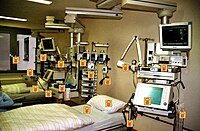
Photo from wikipedia
Abstract Objective: This study aims to describe bacterial and antimicrobial sensibilities in late-onset healthcare-associated infections (HAIs) with laboratory confirmation in a Neonatal Intensive Care Unit (NICU) of a public hospital… Click to show full abstract
Abstract Objective: This study aims to describe bacterial and antimicrobial sensibilities in late-onset healthcare-associated infections (HAIs) with laboratory confirmation in a Neonatal Intensive Care Unit (NICU) of a public hospital in Ceará. Methods: This was a cross-sectional study conducted from January 2013 to December 2017. The bacterial types involved in late-onset HAIs, their sensitivity to antimicrobials, and their multidrug resistance were evaluated. The latter was classified according to the criteria revised by the Pan-American Health Organization as multidrug resistance (MDR), extended drug resistance (XDR), or pandrug resistance (PDR). The description of the variables was performed through proportions and frequency distribution depicted in tables. Results: Of the 427 patients with late-onset HAIs, 47 (11.0%) had bacterial infections confirmed by blood cultures, and 7 (14.9%) had infections caused by MDR bacteria. Among the types of bacteria, 26 (55.3%) were Gram-negative bacteria, and 21 (44.7%) were Gram-positive bacteria. Among the Gram-negative bacteria, 92.3% (n=24) showed resistance to more than one antimicrobial, especially to ampicillin (81.2%), cefepime (33.1%), gentamicin (19.4%), and piperacillin/tazobactam (17.2%). Among the MDR ones, three cases had Klebsiella pneumoniae, and three had Pseudomonas aeruginosa, classified as two MDR and one XDR, and three XDR, respectively. Gram-positive resistance to penicillin was the most common one (80.0%), and approximately half of the strains being resistant to oxacillin. Susceptibility was high to vancomycin (97.5%), but one microorganism was resistant to oxacillin and vancomycin. Conclusions: The emergence of MDR strains is a reality in NICUs, carrying the risk of therapeutic failure and requiring continuous prevention protocols aimed at minimizing the risks of contamination by bacteria with high morbidity and mortality.
Journal Title: Revista Paulista de Pediatria
Year Published: 2023
Link to full text (if available)
Share on Social Media: Sign Up to like & get
recommendations!